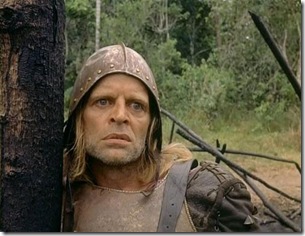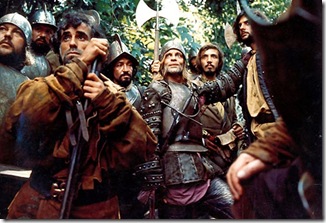1972
Director Werner Herzog
Werner Herzog has always professed both his admiration and fear of nature. Concurrently, he has repeatedly claimed similar feelings towards his closest - if an artist such as he could ever have such a thing - muse, the eccentric and magnetic Klaus Kinski. It is apt then that the two men’s very first collaboration, 1972’s Aguirre, the Wrath of God, should reflect this psychological dichotomy more successfully than any of the other four films the two men worked on together.
Concurrently, he has repeatedly claimed similar feelings towards his closest - if an artist such as he could ever have such a thing - muse, the eccentric and magnetic Klaus Kinski. It is apt then that the two men’s very first collaboration, 1972’s Aguirre, the Wrath of God, should reflect this psychological dichotomy more successfully than any of the other four films the two men worked on together.
Filmed within the Peruvian rainforests along the Amazon, the first shot of Aguirre shows Gonzalo Pizzaro’s doomed army marching down the long, winding slopes of Machu Pichu. It is a gorgeous representation of man’s invasion of nature and its consequence on the human soul, the overriding theme of Herzog’s sixth feature. A famous quotation from the divisive director asserts, “I like to direct landscapes just as I like to direct actors and animals.” Not a single word of dialogue is uttered for close to five minutes, as Herzog’s camera feasts on the visual spectacle of the mountain, before gradually introducing the snaking, slithering presence of the Spanish convoy. It remains the only part of Aguirre where the landscape is completely dominant. Herzog, in the 2002 documentary My Best Fiend, claimed that Kinski was unhappy with this panoramic approach, desiring a greater emphasis placed upon his own stern features. What follows this opening five minutes is much more suited to the actor’s taste; Herzog’s camera grows closer and closer to the character of Don Lope de Aguirre, an astonishingly vile villain of truly Shakespearean proportion, echoing the scheming machinations of Othello’s Iago, the sadistic ambition of King Lear’s Edmund or, most blatant of all, the delusional paranoia of Macbeth. By the closing moments we are left with nothing but the man himself soliloquizing hypnotically as he stands upon a crumbling raft of corpses.
 Though based loosely on recorded historical events, Herzog’s script abandons any effort to remain completely factual, so fascinated is it by the ferocious figure of Aguirre. Such surgical scrutiny on a single character is deeply reliant on the actor’s ability, and Kinski gives his greatest and most manic performance as the treacherous and delusional megalomaniac. He and Herzog, despite their occasional hostilities, were always successful in creating memorable roles for Kinski to inhabit. The films were not always necessarily of the same standard, but whether giving his own unique take on Count Dracula in Nosferatu the Vampyre (1979) or taking on the titular role of the tragic Woyzeck (1979), Kinski’s unique energy remains unmatched. His only other that comes close to surpassing that of Aguirre is his ambitious performance as Brian Fitzgerald in another Herzog feature depicting man’s conflict with nature, Fitzcarraldo (1982), a character who matches the delusional ambition of Aguirre, but without the sadistic hatred of God.
Though based loosely on recorded historical events, Herzog’s script abandons any effort to remain completely factual, so fascinated is it by the ferocious figure of Aguirre. Such surgical scrutiny on a single character is deeply reliant on the actor’s ability, and Kinski gives his greatest and most manic performance as the treacherous and delusional megalomaniac. He and Herzog, despite their occasional hostilities, were always successful in creating memorable roles for Kinski to inhabit. The films were not always necessarily of the same standard, but whether giving his own unique take on Count Dracula in Nosferatu the Vampyre (1979) or taking on the titular role of the tragic Woyzeck (1979), Kinski’s unique energy remains unmatched. His only other that comes close to surpassing that of Aguirre is his ambitious performance as Brian Fitzgerald in another Herzog feature depicting man’s conflict with nature, Fitzcarraldo (1982), a character who matches the delusional ambition of Aguirre, but without the sadistic hatred of God.
The negative side to Kinski’s performance, however, is also its greatest strength: it dominates. Don Fernando de Guzmán is portrayed by Peter Berling as a corpulent fool, perhaps the most visibly unsuited to his current hostile surroundings and false authority than any other character; even the pampered women accompanying the journey, Helena Rojo’s Doña Inéz and Cecilia Rivera as Aguirre’s own daughter seem more at ease than the self-proclaimed “Emperor in the New World”, but feature too scarcely to have any real impact. The only other character to rival Aguirre is, as Herzog would see it, the landscape itself. It is not the fault of the actors, as their characters are thinly drawn figures only there for nature to dispose of and for Kinski’s unpredictable rogue to toy with.
**** / *****
No comments:
Post a Comment